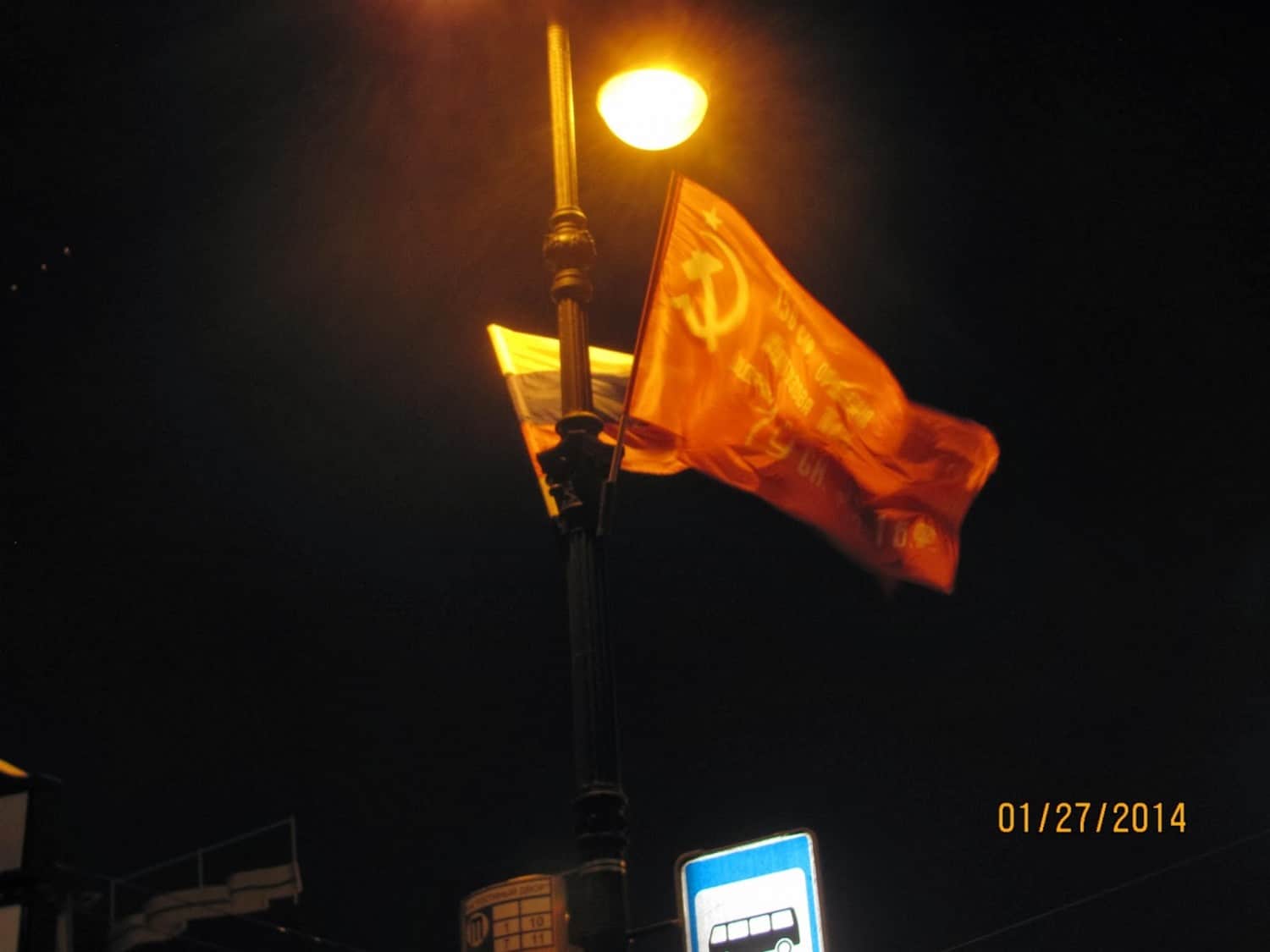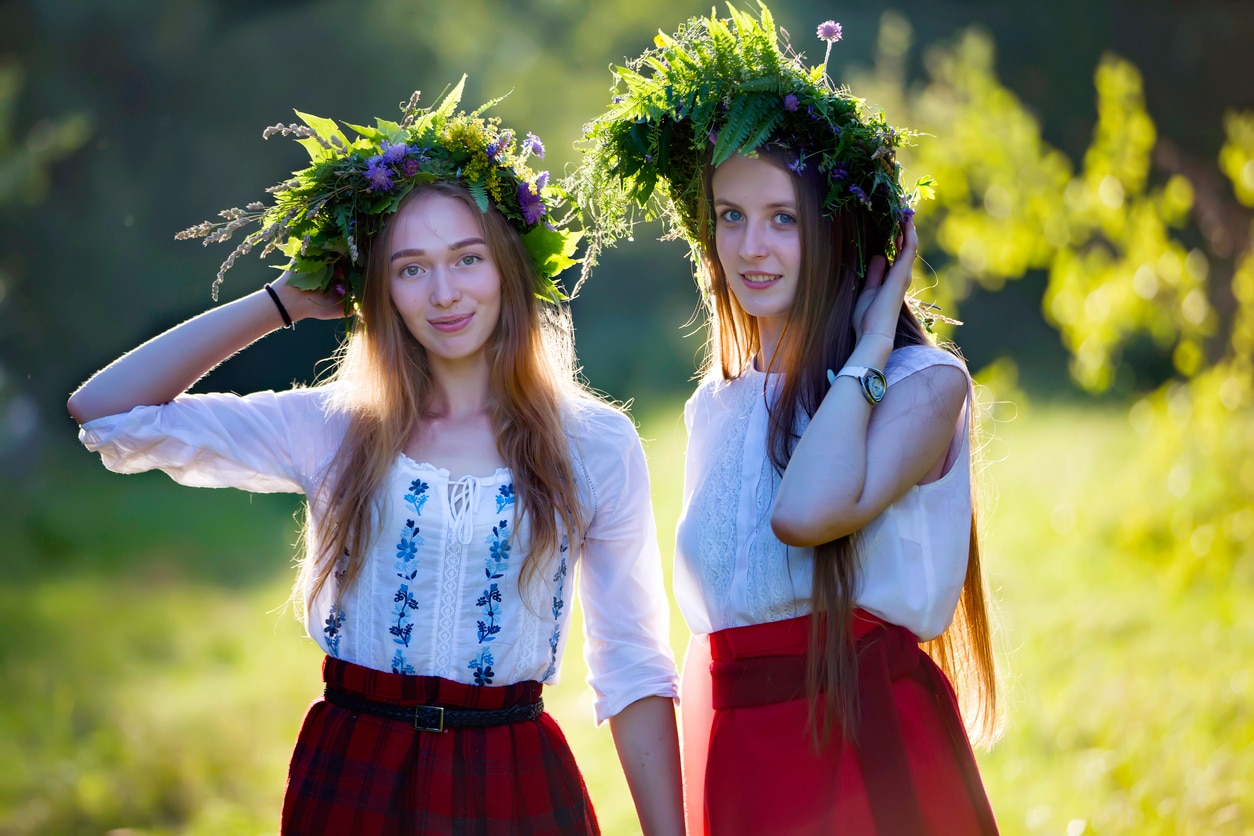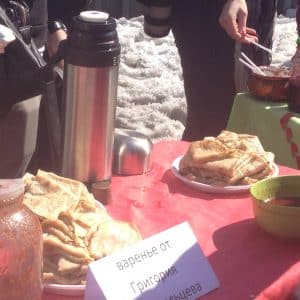Maslenitsa is ancient holiday that still takes many Slavic nations by storm every spring. Celebrations are held to mark the imminent end of winter with mountains of hot, delicious blini and revelry.
Originally a pagan holiday celebrated as early as the 2nd century A.D., Maslenitsa has been somewhat folded into Orthodox Christian traditions and is celebrated the week directly preceding Lent (known in Russian as “Великий пост,” or “The Great Fast”).
Blini were originally eaten because they’re hot, round, and golden like the sun, but Orthodox Christians retained the tradition because they’re prepared from milk, eggs and butter–the richest foods still available to practitioners, as meat was already forbidden. Some argue that the blini are now reminiscent of the halos that are seen over saints’ heads in Orthodox icons.
Maslenitsa festivities were once spaced out with specific days for specific activities over the course of a week. Today, most of the traditions are still kept, and one can find city-sponsored events and, of course, blini almost everywhere throughout Russian cities for the full week. Most of the celebrations, though, are now packed into a weekend to match modern city life. The Orthodox Church has co-opted many of the festivities and encourages those that move people to ask forgiveness of each other, share food, spend time outdoors and visit family. Maslenitsa’s other traditions, such as snowball fights, wrestling, climbing poles in one’s underwear, and effigy burning are officially frowned upon by the church, but remain wildly popular and even supported in official city celebrations.
Katheryn Weaver – Moscow, 2018
Katheryn Weaver is a student of rhetoric and history at the University of Texas, Austin. Her primary areas of investigation include revolution and the rhetorical justification of violence against individuals, state, and society. She is currently studying Russian as a Second Language with SRAS’s Home and Abroad Scholarship.
I had the good fortune of indulging in festivities with a handful of other first-timers. We began our day on Tverskoi Ploshad in central Moscow with blini stone-baked next to an open flame, a folk concert and traditional games, including tug of war and another than involved a burly man chasing a woman around a group of people standing in a circle and holding hands. The object was to confuse the woman into running directly into the man’s arms, while the people holding hands tried to offer the woman different escape routes.
We soon wandered to a smaller festival on Kamergerckiy, a pedestrian street, which was mainly concerned with trinkets and souvenirs, before moving to Manezhnaya Ploshad. Located a stone’s throw from the Kremlin, the Manezhnaya festival was by far the largest with more than 20 food vendors and countless trinket stands. Tarragon jam (made using a similar process that produces Tarkhun) was among the most unusual products we found!
After taking a stroll down Old Arbat, where we found a traditional folk dancers performing in the street, we made our way to Gorky Park, where we enjoyed our final blini. Although we could choose from such delicacies as strawberry, caviar, beet, and blueberry flavored (not stuffed!) blin, condensed milk was the blin of choice–along with a piping hot mug of sbiten, a hot drink of water, honey, and spices that was popular in Russia for centuries before being replaced by coffee and tea in the 1800s. Gorky Park also boasted an ice skating rink, and an ice-tubing mountain.
Above: Moscow’s Hare Krishnas came out to celebrate on Maslenitsa.
Although most every stand sold a salmon or red caviar blin, only the occasional stand sold a meat-filled option. After all, the traditions of Maslenitsa call for specifically meatless foods. But if you’re ending the evening with a blin so hot and fresh your fork melts, what else could you possibly need?
Two things stand out in modern Maslenitsa traditions. The first is their sheer scale: we wandered through a large part of central Moscow, encountering celebrations almost everywhere. There were even more events throughout the city and colossal celebrations held outside the city. The amount of support given to the holiday by both the Russian public and the authorities shows its importance to modern Russian identity.
Above: More images from Moscow’s 2018 Maslenitsa celebration.
In fact, the holiday is increasingly referred to as “Russian Maslenitsa” (Русская масленица). This helps differentiate it from similar traditions, such as Mardi Gras in the West and the more closely related Masopust in Czechoslovakia. It also emphasizes the second important aspect of the holiday: it is seen as tradition that gets to the very roots of what it means to be Russian. While it holds some religious context, it is openly celebrated as a holiday with pagan roots – reaching back even further than Orthodoxy and the Baptism of Rus, into the prehistory of the pagan Slavs that is regarded as equally important to modern Russian identity.
More than anything, Maslenitsa is widely observed as an excellent opportunity to see friends and family, spend time outside, and enjoy a delicious blin (or 12).
Rylin McGee – Irkutsk, 2018
The week leading up to “Forgiveness Sunday” in Irkutsk brought a much needed extra boost of cheer to the city following the bitterly cold first half of February.
Throughout the week, I visited a variety of restaurants and cafes for lunch, and sometimes out of necessity in order to warm up with a cup of tea. Inside, regardless of whether or not blini existed as permanent options on the menu, just about every eatery offered a special holiday menu, featuring traditional toppings, such as caviar, jam, and sour cream, as well as more contemporary options, such as banana with Nutella.
Several museums featured special Maslenitsa displays and presentations, including Window to Asia, a regional Irkutsk museum of local lore, which I attended for a Maslenitsa presentation. Here, students learned about the history of Maslenitsa, and how it developed from both Pagan and Christian traditions. I visited on a Tuesday, which during Maslenitsa, is traditionally known as “game day.” Thus, we participated in a variety of traditional games, including hobby horse races, tongue twister competitions, and a tug of war.

Sunday of course, was the most festive of all. Although there was plenty going on inside the city limits of Irkutsk, I and the rest of the SRAS students celebrated by taking a ride out to Тальцы, an open air museum showcasing traditional wooden architecture 40 minutes south of Irkutsk. There, we found a popular festival that offered a wide range of traditional celebrations being enjoyed by crowds of Russians. Children dove down ice slides, families toured the village on horse drawn sleighs, and some even chose to admire the surrounding taiga with a quick dog-sled ride. Swings, wooden stilts, and walking skis were scattered around the village for people try, often resulting in a failed attempt but a good laugh.
Most notable was the scent of freshly prepared food. Dozens stood in line for made-to-order blini, caramel apples, smoked fish, and popcorn. Although Maslenitsa is traditionally a meatless week for the Russian Orthodox, there were also many popular stands with shashlik (skewered meat) and Uzbek plov (lamb pilaf). Lines were long but people were kept occupied by the live singing and dancing, as well as the traditional pole climbing competition, in which a contestant, stripped down to their underwear, attempted to climb a smooth pole, with the objective to reach a small present located at the top. Then, near the end of the day, the festivities were brought together with the most infamous tradition of the holiday: the burning of Maslenitsa. The destruction of the effigy marks the death of winter and the arrival of spring.

I was grateful to be in Russia during the week of Maslenitsa because it exposed an aspect of Russian culture which is not commonly shared in the media. I saw how Russians, who are normally portrayed without a smile, are just as festive, if not more, than everyone else. Additionally, I saw the degree to which Russians have continued to maintain family traditions and take pride in ancient cultural practices. While to outsiders, the holiday may seem like simply an opportunity for good food and fun, after experiencing the holiday in Irkutsk, I can tell that the holiday still maintains its pagan flare as well as Orthodox connections connection to the Great Lent. The stories, traditions, and history of the holiday were widely engrained, shared and practiced through the week’s events.
Charlie Bacsik – St. Petersburg, 2018
During the week of Maslenitsa, there were several celebrations that took place across St. Petersburg. The largest, week-long festival was held in the city center, with organized concerts and shopping booths for food and souvenirs. This was definitely the most popular Maslenitsa celebration I witnessed, although it felt a bit touristy. My university here, St. Petersburg State University of Economics, also hosted a small celebration for students, especially those coming from different countries. All of the international students got to participate in traditional singing/dancing games, and were treated to free blini with condensed milk, or “сгущенка.”
On the last day of Maslenitsa week, my fellow SRAS students and I went out to a small neighborhood in St. Petersburg to witness a more traditional celebration. The event, as small as it was, still included live concerts, various activities for all family members, and several food stands where you could buy blini, shashlik, and meat/fruit pies (пироги). Also, for every three games you participated in, you received a free blini with fruit jam! There were children with small sleighs being pulled through the snow and an abundance of singing and dancing. At the end of the celebration, everyone gathered around the hand-decorated Lady Maslenitsa and watched as she was set aflame. The entire event was organized by a group of women in charge of a local culture committee. While the celebration might have been smaller than others, the overall atmosphere and joy brought by the locals made it clear that Maslenitsa is a treasured, long-standing tradition within their community.

Above: A young Russian woman shares her local Maslenitsa traditions via her personal vlog in St. Petersburg.
Jordan Bryant – Vladivostok, 2013
If you happen to be in Russia during the spring, one of the highlights of the season (along with the melting ice and ubiquitous mud) is the celebration of Масленица (Maslenitsa). Eight weeks before Easter, this week-long holiday not only heralds the beginning of spring, but also signals the beginning of the Great Fast (Великий Пост; Velikii Post) on the Orthodox calendar. As is the case with many an Orthodox celebration, Масленица was originally an ancient Slavic tradition, and once the start of the new year. To symbolize the return of the sun and the bountiful harvest that it will hopefully provide, all week long блины (bliny; crepes/pancakes) are eaten by the mountain-ful, complete with such scrumptious fillings as jam (варенье; varen’ye), honey, sweetened condensed milk (сгущенное молоко; sgushchennoye moloko) and sour cream, or, just as often, plain but slathered with butter. Relatives call upon each other regularly, and there are even specific days allotted for the visiting of certain loved ones (e.g. Wednesday son-in-laws are treated to блины at their mother-in-law’s). Furthermore, the week is traditionally filled with fun and games, such as sleigh-riding, the building of snow cities, fist fights, dancing, puppet shows and clown performances.
In short, it’s a really fun time of year! And just because many students are far from home, doesn’t mean that we here at VSUES didn’t celebrate to the best of our ability! Due to the rigors of the school week, the marking of Масленица was limited to one big blowout party on Friday, March 15. Everyone got started early in the morning, cooking up блины. Each floor of the dormitories made their own versions, and let me tell you, there were some really tasty takes on the traditional recipe! I, of course, was in the thick of the action, and contributed some of my own cooking expertise to the mix. After everything was prepared, the cooks joined the main party outside on what is a basketball court during the rest of the year, but which this day had been transformed into a fairground! There, we sampled literal piles of блины with every filling imaginable, indulged in piping hot cups of tea and watched the Масленица entertainments. Some of these had been modified from their traditional forms, such as the fistfights (transformed into pillow fights), but the dancing and clown performances, for example, remained unchanged. All in all, the day was uncharacteristically warm, spirits were high, the food was abundant and excellent, and the entertainments were jolly good fun. It was certainly a banner day at VSUES, and hopefully the harbinger of a wonderful spring to come!
Danya Spencer – Irkutsk, 2012
And finally – Bashkir Maslenitsa is one of Russia’s most ambitious celebrations, held every year outside Moscow.
You’ll Also Love

The 70th Anniversary of the Liberation of Leningrad
Jan 27, 2014 was the 70th anniversary of the end of the Siege of Leningrad. During the Great Patriotic War (WWII) German forces cut off the Soviet city of Leningrad (now Saint Petersburg) from the rest of the country with intense bombing raids and tank roadblocks. The siege lasted for 872 days: from September 8 […]

Corpus Christi in Poland: Student Observations
Corpus Christi is a Catholic holiday celebrating the Blood and Body of Christ. Since Poland is majority Catholic, most stores and eateries in the country are closed for this very popular day. As a participant in SRAS’ study abroad programs in Warsaw, I was given the opportunity to spend the day with my peers to […]

Christianity and Paganism in Russia: Моя Россия Blog
In this text, Tajik blogger Roxana Burkhanova describes, in Russian, the history and current status of Christianity and paganism in Russia as well as touches upon issues of religious freedom. While Orthodox Christianity is the most popular and politically powerful religion in Russia, pagan traditions still survive and other Christian faiths exist. This is part […]

Tiger Day in Vladivostok: Student Observations
The fourth Sunday of every September in Vladivostok is set aside for a local holiday called “День Тигра” (“Tiger Day”). The event celebrates the Amur (also called Siberian) Tigers, whose natural habitat is the Primorsky Krai Region of the Russian Far East. Vladivostok’s coat of arms prominently features the Amur Tiger, and there are quite […]

Once Upon a Time in Eastern Europe: Memoirs of a Soviet Child
To the reader: These vignettes are a collection of personal essays of my childhood experiences growing up in the former Soviet Union and my later impressions based on travels to Ukraine and to Russia as a college student. Please be aware that since most of my childhood was spent in the Ukrainian SSR while it […]






















